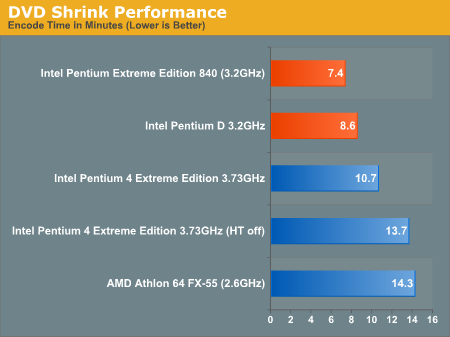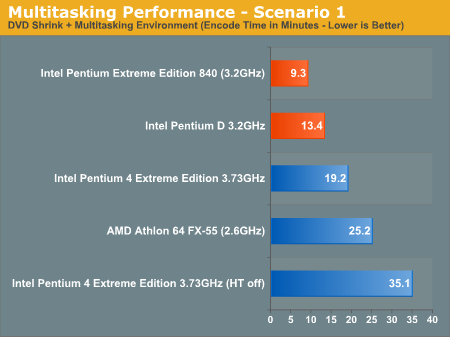Intel Dual Core Performance Preview Part I: First Encounter
by Anand Lal Shimpi on April 4, 2005 2:44 PM EST- Posted in
- CPUs
Multitasking Scenario 1: DVD Shrink
If you've ever tried to backup a DVD, you know that the process can take a long time. Just ripping the disc to your hard drive will eat up a good 20 minutes, and then there's the encoding. The encoding can easily take between 20 - 45 minutes depending on the speed of your CPU, and once you start doing other tasks in the background, you can expect those times to grow even longer.
For this test, we used DVD Shrink, one of the simplest applications available to compress and re-encode a DVD to fit on a single 4.5GB disc. We ran DVD Decrypt on the Star Wars Episode VI DVD so that we had a local copy of the DVD on our test bed hard drive (in a future version of the test, we may try to include DVD Decrypt performance in our benchmark as well). All of the DVD Shrink settings were left at default, including telling the program to assume a low priority, a setting many users check in order to be able to do other things while DVD Shrink is working.
As a single application with no multitasking involved, here's how DVD Shrink performs:

As you can see, the new dual core chips can shrink a DVD in about 70% of the time of the 3.73EE. But what happens to performance when you start doing other things in the background?
In order to find out, we did the following:
1) Open Firefox and load the following web pages in tabs (we used local copies of all of the web pages):
We kept the browser on the AT front page.
2) Open iTunes and start playing the latest album of avid AnandTech reader 50 Cent on repeat all.
3) Open Newsleecher.
4) Open DVD Shrink.
5) Login to our news server and start downloading headers for our subscribed news groups.
6) Start backup of Star Wars Episode VI - Return of the Jedi. All default settings, including low priority.
DVD Shrink was the application in focus; this matters because by default, Windows gives special scheduling priority to the application currently in the foreground (we will test what happens when it's not in the foreground later in this article). We waited until the DVD Shrink operation was complete and recorded its completion time. Below are the results:

Now, we start to see where dual core helps. In this relatively simple multitasking scenario, the DVD shrink task took more than twice as long on single core CPUs than it did on dual core chips. The Pentium 4 without Hyper Threading took a full 35 minutes to complete the task, compared to the 9.3 minutes of the dual core Pentium Extreme Edition. Even the fastest from AMD couldn't hold a candle to the dual core offerings.
And this was only with a minimal amount of multitasking. Had more applications been running or had actual user interaction taken place during the test, the dual vs. single core gap would've grown even more.










141 Comments
View All Comments
nserra - Tuesday, April 5, 2005 - link
Amd dualcore platform is right here today, the processor is not. And i dont see that a bad thing, upgradable as always been a good thing.#65 "Yes, same will also apply to the AMD's solution. Both CPU cores in dual core Opteron will share same bus and memory controller."
I am not really sure about that, amd always said the processor was being done dualcore since day one that must mean something. Dont forget that socket 939 is dual channel it could be possible to give one memory channel for one processor and the other channel for the other.
matthewfoley - Tuesday, April 5, 2005 - link
You people screaming for the gaming benchmarks, RTFA. Gaming or any other single threaded application will have identical results to a similarly clocked single core proc.ceefka - Tuesday, April 5, 2005 - link
#62 I read the article and think it's a rant, just a rant, no facts, just implications. I can sympathise with the feeling that Intel is let off the hook, for now.I do hope that games will be a substantial part of the benchies once the traditional AMD vs Intel dual core tournament takes place. Remember the pre-release benchies of the Opteron (that Italian thing)?
I also think that shrinking DVD's while typing in MS Word and listening to mp3 is about the maximum of things to do simultaneously. I have to get my head around it as well, you know ;-). It does however open a way to have someting like a home server or HTPC for everything but the most extreme stuff. It could record a TV-show, while watching a DVD and the wife chatting away on another screen.
Some say that dual core will have more benefit in servers because of the typical threaded applications. That's a good point. Can we look forward to a comparison of a 2 and 4-way dual core Opteron vs Xeon on typical server applications, workstation apps and maybe a few games just for fun.
smn198 - Tuesday, April 5, 2005 - link
lol @ #11 "now Intel is going to start eating AMD's lunch"Do you mean eating AMD for lunch? I think I prefer it your way.
RLandon - Tuesday, April 5, 2005 - link
The multitasking benchmarks clearly shows that Windows doesn't deserve to be refered to as an operating system.ceefka - Tuesday, April 5, 2005 - link
The price-difference between a dual and single core might not be too big on an Intel CPU, but you MUST get a new board. So the actual price difference when upgrading is $80 + brand new 955x motherboard. Nice one, Intel. A new board will cost you around $ 100 at least: actual difference $ 180. If AMD can stay under that difference they're at least competitive in pricing.Benchies are promising/impressive though. Wonder what the 64-bit benchies would be. Too bad that the introduction of dual-cores is in different segments (desktop vs server). Can't wait for some traditional Intel vs AMD benching ;)
#2
Read this article
http://www.anandtech.com/cpuchipsets/showdoc.aspx?... page 3, last paragraph.
AMD's Fred Weber finds Hyperthreading a "misuse of resources". AMD have always said two cores are better than a single core acting like one.
defter - Tuesday, April 5, 2005 - link
"INTEL's dual core isn't really dual-core, it's just two CPUs stick together"dual consisting of or involving two parts or components usually in pairs; "an egg with a double yolk"; "a double (binary) star"; "double doors"; "dual controls for pilot and copilot"; "duple (or double) time consists of two (or a multiple of two) beats to a measure": http://dict.die.net/dual/
Yes, two CPU stuck together can be called "dual core".
"the two cpus share the same bus, without any logic in between."
Yes, same will also apply to the AMD's solution. Both CPU cores in dual core Opteron will share same bus and memory controller.
IntelUser2000 - Tuesday, April 5, 2005 - link
130W isn't actually bad. The Xeon MP Potomac had TDP of 125W and max power of 136W, saying probably due to EIST, the difference is much less now. Plus, you aren't running two cores all the time, so if you are playing games only, then you would have 65W power consumption.Hmm... I wonder if the reason 1066MHz is not supported by any of the dual core processors is to dedicate more bandwidth of the Dual-DDRII-667 to integrated graphics. Or maybe we would see Yonah with 1066MHz bus as desktop?
IntelUser2000 - Tuesday, April 5, 2005 - link
falcc - Tuesday, April 5, 2005 - link
No games tested at all? Since when does this happen? Intel doesn't want dual core to look bad so Anandtech doesn't bench ANY games at all.Come on guys, judging by the article below on the Inquirer I'm not the only one who is suspicious.
http://theinquirer.net/?article=22332